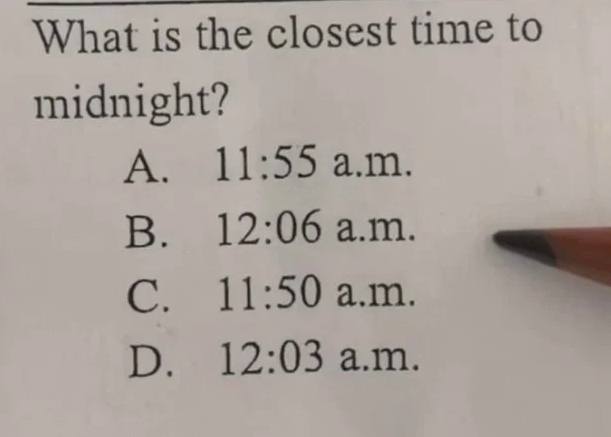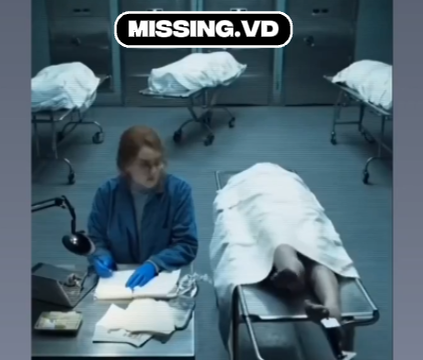Who doesn’t love a good brain teaser? Recently, a math puzzle has taken the internet by storm, challenging the problem-solving skills of people around the world. Though originally designed for kids, this puzzle has captured the minds of people of all ages, sparking a lively debate online. It all started on Reddit, where what seemed like a simple question soon turned into a viral sensation that had everyone thinking twice.

In June 2023, a Reddit user from Jamaica, known as @yawdmontweet, posted a puzzling question that set off this global conundrum: “What is the closest time to midnight?” The options provided were:
- A. 11:55 a.m.
- B. 12:06 a.m.
- C. 11:50 a.m.
- D. 12:03 a.m.
What at first seemed like a straightforward question quickly spiraled into a full-blown debate, accumulating over 1.4 million views and thousands of comments. The phrase “closest time to midnight” opened the door to multiple interpretations, turning this seemingly innocent puzzle into a hot topic of discussion across the internet.
The Debate: Which Time Is Closest to Midnight?
The majority of Reddit users leaned toward option D—12:03 a.m.—as the answer to the puzzle. The reasoning was fairly simple: 12:03 a.m. is just three minutes past midnight, which makes it the closest time immediately after midnight. In their eyes, the answer was clear-cut because it literally followed midnight by only a few minutes.
However, not everyone agreed with this solution. Some people pointed out that the wording—“closest time to” as opposed to “closest time after”—could change the interpretation entirely. For instance, option A (11:55 a.m.) was argued to be the closest time to the upcoming midnight when viewed from the context of being in the morning, suggesting that the next midnight was still hours away but closer compared to the other times provided.
Other participants in the debate chose to take a more creative angle in their reasoning. They wondered if the concept of “midnight” itself should play a role in the choice. For example, since option A (11:55 a.m.) is the closest time leading up to the next midnight, some people argued it could be considered closer in relation to midnight overall, since it came directly before it later in the day.
What Did AI Say?
With the debate raging on, some users decided to consult artificial intelligence to get a definitive answer. ChatGPT, a popular AI chatbot, confidently declared option D (12:03 a.m.) to be the closest time to midnight. This response seemed to align with the majority’s logic—since it’s the time that’s just three minutes after midnight, it’s clearly the closest from a chronological standpoint.
This response from ChatGPT added even more fuel to the fire, with some people agreeing wholeheartedly while others insisted there were alternative ways to interpret the puzzle. It was evident that this simple question was much more complicated than it initially seemed.
Breaking Down the Options
Each answer choice offered its own unique perspective:
- Option A: 11:55 a.m.
Pros: It’s the closest time to the next midnight when viewed in the context of the whole day, which made it a viable choice for those thinking long-term.
Cons: It is not the closest time immediately following midnight, which many people considered important. - Option B: 12:06 a.m.
Pros: It’s only six minutes past midnight, making it still relatively close.
Cons: It is slightly farther from midnight compared to 12:03 a.m., which was why most did not choose this as their final answer. - Option C: 11:50 a.m.
Pros: It comes before noon, indicating it’s closer to the upcoming midnight than later times.
Cons: Compared to the other options that occur after midnight, this time is farther away. - Option D: 12:03 a.m.
Pros: It’s only three minutes after midnight, which makes it the closest time to the point of midnight itself.
Cons: There weren’t many drawbacks, as this option directly addressed being close to midnight in a very literal sense.
What Makes This Puzzle Special?
This puzzle isn’t just about figuring out which time is closest to midnight; it also reflects the different ways our brains approach problem-solving. It challenges us to think critically, consider multiple perspectives, and engage in a bit of friendly debate. It’s the perfect example of how simple questions can have layered answers, depending on how we interpret the phrasing and context.
The viral nature of this math puzzle shows us that even a basic question can inspire deep thought and discussion. Whether you align with option D for its obvious proximity after midnight, or whether you prefer one of the other choices because of how you interpreted “closest,” this puzzle is a great reminder of the joy that comes from diving into complex problems.
Where Do You Stand?
So, what do you think? Is 12:03 a.m. really the closest time to midnight, or is there more to consider here? Perhaps there’s more than one valid answer, depending on how you interpret the phrasing of the question. Either way, this brain teaser has succeeded in entertaining and challenging people around the world.
Feel free to jump into the debate yourself! Which option do you think is correct? Sometimes, the fun lies in the discussion itself—seeing different perspectives and broadening the way we think about even the simplest questions.
This article aims to engage readers with a mix of detailed analysis, creative thinking, and an invitation to join the conversation, ensuring it’s both informative and captivating.





